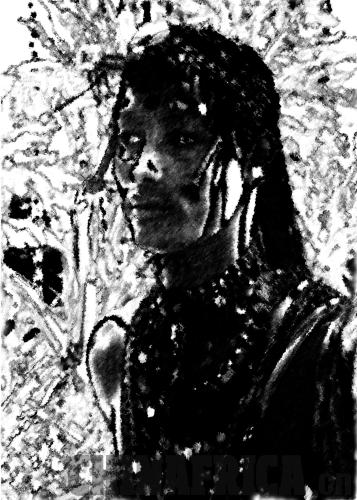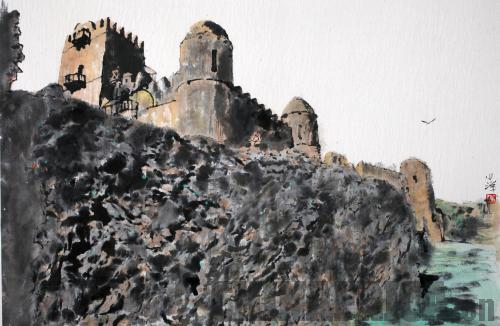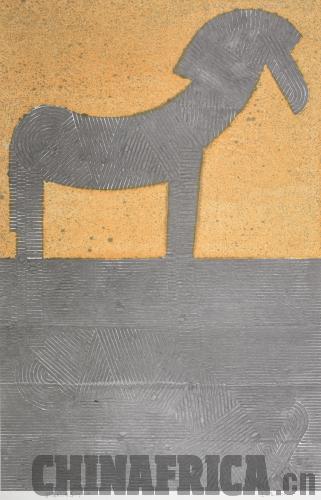| There is no historical evidence of a connection between Chinese and African art, but today, artists from the two sides are making efforts to build just such a connection. On June 18, an art exhibition entitled Approaching Africa was held at Shenzhen University's art museum. The exhibition included more than 60 works by nine artists from Shenzhen's art institutes. The works were created by the artists during a tour of African countries including Benin, Kenya, Tanzania, Ethiopia and Zimbabwe.
Chinese artists are not the only ones to draw inspiration from other countries. African artists have also visited China in search of their own personal Eastern muse. During the past few years, hundreds of African and Chinese artists have explored each other's cultures through this exchange program under the Chinese and African Culture in Focus, an annual series of events organized by the Chinese Ministry of Culture. These artists have developed their understandings of different lifestyles and expressed their newfound knowledge through their art. Their works are inspiring more artists and providing new insight into foreign cultures for common people. Four artists spoke with ChinAfrica and shared their feelings about their visits to African countries.

Dong Xiaoming
My visit to Benin, Kenya, and Tanzania was a good opportunity for me to personally visit and get to know Africa, a continent which was unfamiliar and mysterious to me. For years I have used the lotus as a main theme of my works, depicting it by using a combination of both traditional and modern Chinese water ink painting techniques. But during my visit to Africa, what inspired me most was African people. I saw splendid landscapes, but they were not as impressive as the local people. As a Chinese artist, I was touched by the stories in their history. When I made friends in Africa, I felt a strong desire to depict them. I wanted to know more about them, to understand and interpret them. They are lovely people, and I could feel a heart-to-heart connection with them.
Wen Zhenfei
In Zimbabwe, I was amazed by the stone sculptures I saw. Through them, I could see how European art was influenced by African art. You could say that ancient African art has bred contemporary European art. Some features and elements found in the works of famous masters like Picasso can all be found in African art. At the beginning of the 20th century, European art made a breakthrough on the basis of its own traditions by learning from foreign cultures. This enlightened many contemporary artists, who then used different art styles and forms of expression from other countries and cultures.

Yang Xiaoyang
To get inspiration and create works while visiting the African continent is the desire of many Chinese artists. During the 25 days I spent in Ethiopia, I learned a lot. Ethiopia is one of the poorest countries in the world, but I didn't see any signs of mental distress among local people while I was there. This is very unlike Chinese society, where many people often complain that they are unhappy. Accompanied by our African friend Daniel, we visited local art institutions and communicated with local artists who had visited the Shenzhen Art Institute. We were impressed by the hospitality of our Ethiopian counterparts. I told Daniel that he should paint China using African painting techniques. Back in China, I painted African landscapes and culture using Chinese painting techniques. It was a challenge and experiment for me. I hope that the increasing exchanges between Chinese and African artists will further promote Sino-African friendship.

Wang Lixing
I feel grateful to have had this opportunity to visit Tanzania. Since the 1980s, many painters from Chinese art circles have gone to Africa, where they learned and found inspiration. Shi Hu is a particularly well known example. The works he created in Africa rose to fame once they were unveiled in China. Since then, many Chinese artists have dreamed of going to Africa. I think the reason may be that the ecology, lifestyle and people in Africa lend themselves well to artistic interpretation and expression. In Tanzania, what impressed me most was that the local artists felt no limitations or constraints, and traditional arts and crafts are still widely used and practiced. I saw a lot of exquisite wood carvings that had been made only three or four decades ago, but were carved with incredible skill. I think this demonstrates the artistic character of the whole African continent: limitless, free, and seeking to be one with God. This is the highest level to which art can aspire. |